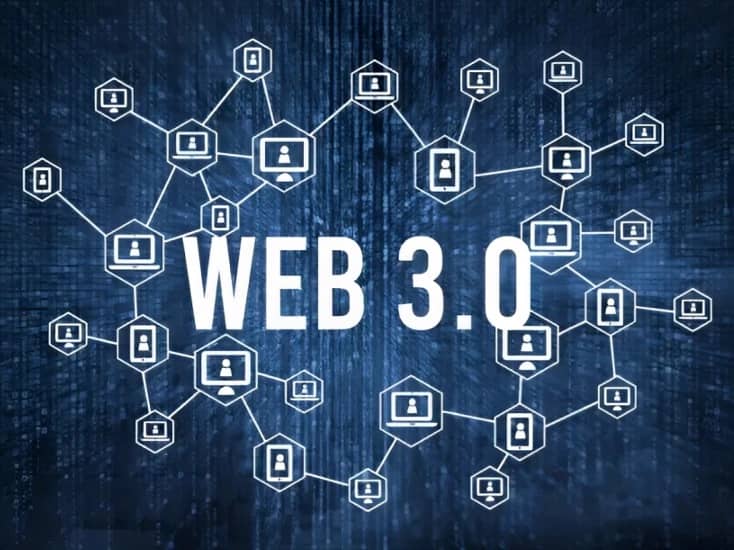订阅 wiki
Share wiki
Bookmark
Web3
Web3
Web3(也称为Web 3、Web 3.0)是下一代互联网技术,主要依赖于机器学习、人工智能(AI)和区块链技术。Web3代表一种无服务器互联网架构,通常称为去中心化网络,旨在为个人提供对其数据访问和管理权的控制,而不是任何中心化机构。[1][2][3]
根据Web3基金会的说法:
Web 3是无服务器互联网的愿景,即去中心化网络。在这个互联网中,用户可以控制自己的数据、身份和命运。[4]
琐事
- “Web 3.0”的概念由以太坊联合创始人加文·伍德在2014年以太坊推出后不久提出。
- Web 3.0建立在去中心化、开放性和更大的用户效用的核心概念之上。
- 在Web3上,用户将拥有他们的数据的所有权,而不是中心实体。
- 2022年,大多数互联网平台仅由少数几家强大的公司控制,这些公司从用户生成的数据中获利。[5]
- 采用Web3的顶级区块链项目和服务包括Uniswap、Polygon、Axie Infinity、Frax Finance、Polkadot和IQ.wiki。[9]
概述
2014 年,以太坊推出后不久,以太坊的联合创始人 加文·伍德 提出了“Web 3.0”的概念。加文针对许多早期 加密货币 采用者共同关心的一个问题提出了解决方案:Web 需要过多的信任。也就是说,人们今天所了解和使用的大部分 Web 依赖于信任少数几家私营公司以符合公众的最佳利益行事。Web 3.0 旨在让用户控制他们在线访问的内容,并创建语义网。[3]
Web3 由 区块链、自主身份和去中心化存储系统等技术和概念驱动,改变了传统的数据所有权概念,并将权力赋予用户。构建在 web3 生态系统上的应用程序和解决方案是真正去中心化的,集成了增强的安全性、功能、无审查和数据真实性等功能。[6]
技术
Web 3.0 由四项新的技术创新驱动:
- 边缘计算:与 Web 2.0 不同,Web 3.0 将数据中心推向边缘(即边缘计算)并进入用户手中,Web 2.0 改变了数据中心中现有的商品化个人计算机技术。
- 去中心化数据网络:在 Web 3.0 上,用户将拥有自己的数据,因为它是去中心化的。使用去中心化数据网络,许多数据生产者可以出售或共享他们的数据,而无需放弃所有权或依赖中介。
- 人工智能和机器学习:人工智能和机器学习的算法已经发展到可以进行预测并采取有帮助且偶尔可以挽救生命的行为的程度。
- 区块链:区块链 是一种去中心化技术,它使用智能合约来执行交易。这些智能合约定义了 Web 3.0 应用程序的语义。这些智能合约指定了 Web 3.0 应用程序应如何运行。因此,任何想要创建 dApp 的人都需要共享状态机。[6]
历史
Web 1.0:只读 (1990-2004)
1990年,Berners-Lee 作为欧洲研究机构 CERN 的计算机科学家,率先开发了互联网的早期版本。截至 1990 年 10 月,Berners-Lee 编写了构成 Web 基础的三项基本技术,包括第一个网页编辑器/浏览器 (WorldWideWeb.app):
- HTML:超文本标记语言,Web 的标记或格式化语言
- URI 或 URL:统一资源标识符或定位符,用于标识 Web 上每个资源的唯一地址
- HTTP:超文本传输协议,允许从 Web 上检索链接的资源3
20 世纪 90 年代中期,Netscape Navigator 等 Web 浏览器的首次亮相标志着 Web 1.0 时代的开始。当时,大多数互联网用户对电子邮件和实时新闻检索等功能的新颖性感到高兴。内容创作仍处于起步阶段,用户几乎没有机会使用交互式应用程序。[7]
Web 2.0:读写 (2004-2022)
Web 2.0 突出了自 2004 年以来人们利用互联网方式的范式转变。在过去的 15 到 20 年里,Web 1.0 的单调网页已被 Web 2.0 的互动性、社交连接和用户生成内容完全取代。Web 2.0 使全球数百万人几乎可以立即查看用户生成的内容;由于其无与伦比的影响力,这种内容近年来加速发展。
网络从只读演变为可读写。公司不仅向用户提供内容,还开始提供平台来分享用户生成的内容并进行用户之间的互动。随着越来越多的人上网,苹果、亚马逊、谷歌和 Meta 等许多顶级公司开始控制网络上产生的大量流量和价值。Web3 还创建了一种基于广告的收入模式。虽然用户可以创建内容,但他们并不拥有内容,也无法从其货币化中受益。[8]
Web 3.0:读-写-拥有 (2014-2022)
Web 3.0 寻求去中心化和开放互联网。2022 年的互联网用户依赖于网络和蜂窝服务提供商,他们监控通过其系统的数据。借助 区块链 技术,用户可以拥有对其数据的所有权。Web 3.0 代表了 Web 和互联网的下一个阶段,并有可能像 Web 2.0 一样迎来重大的范式转变。去中心化、开放性和提高消费者效用性构成了 Web 3.0 的基础。[7][8]
特性
Web3相对于Web2具有多个优势,同时也包含以下关键特性,这些特性有可能改变当前互联网的状态:[10]
去中心化
Web3代表了一个由区块链技术驱动的去中心化生态系统。构建在web3生态系统上的应用程序和解决方案是真正去中心化的,具有增强的安全性、功能性、无审查和数据真实性等能力。
人工智能 (AI) 和机器学习
Web 3.0 借助语义网和基于自然语言处理的技术,使机器能够像人类一样理解信息。web3 使互联网数据可被机器读取的能力被称为语义网。语义网的概念还旨在实现各种应用程序和企业之间跨链数据共享。语义网以这种方式轻松地分发内容、用户数据和相关信息。此外,机器学习——人工智能 (AI) 的一个分支,它使用数据和算法来模拟人类学习并稳步提高准确性——被纳入 Web 3.0。
连接性
借助Web3,现在可以更轻松地跨应用程序访问内容和信息,并且由于Web 3.0,越来越多的日常设备连接到互联网。物联网就是其中一个例子。
Metaverse capabilities
Web3生态系统支持超逼真的3D空间和图形界面,帮助Web 3项目提供更自然生动的导航用户体验。利用Web 3.0的元宇宙和3D功能,可以根据企业需求设计沉浸式游戏、电子商务商店和NFT市场。[3]
Web3 应用程序
区块链技术被去中心化应用程序使用,这些应用程序不由中心化机构拥有或管理。Web3 支持在功能和可用性方面都得到改进的开发。Web3 dApps 包括元宇宙、DeFi、NFTs、DAOs 和游戏。为 web3 项目设计的 dApps 是真正去中心化和可互操作的。然而,除非项目需要,否则区块链生态系统的 dApps 不一定需要互操作。
Web 3.0 以区块链为核心,支持各种新的应用程序和服务,包括以下列出的内容:
- NFTs:非同质化代币(NFT)是单独唯一的代币,保存在具有加密哈希的区块链中。一些顶级的 Web3 NFT 应用程序包括 Axie Marketplace、Decentraland 和 OpenSea。[11]
- DeFi:去中心化金融(DeFi)利用去中心化区块链技术作为其基础,这是 Web 3.0 的一个新用例,允许提供超出传统中心化银行基础设施限制的金融服务。Web3 DeFi 应用程序的例子包括 Uniswap、Frax Finance、The Graph 和 Chainlink。[12]
- 加密货币:一个新的货币世界正在通过 Web 3.0 应用程序(如加密货币,如 比特币、以太坊、Theta、Filecoin 和 IQ token)创建,该世界力求与传统的法定现金世界区分开来。[14]
- dApp:去中心化应用程序(dApps)是以编程方式运行并记录在不可变的账本中的程序。它们建立在区块链之上,并使用 智能合约 来促进服务交付。示例包括 MetaMask、Brave、Livepeer 和 Magic。[15]
- 跨链桥:在 Web 3.0 时代,有许多区块链和跨链桥提供它们之间的某种连接,例如 Polkadot、Blocknet、Cosmos 和 Wanchain。[13]
- DAOs:DAOs 有望承担 Web 3.0 治理机构的角色,提供一些结构和去中心化治理。示例包括 BrainDAO、MakerDAO、OlympusDAO 和 PieDAO。
发现错误了吗?
